This Too Shall Pass
As the UK, and London in particular, is gripped in a fight against the Omicron variant, we wanted to reassure those planning a walk next year not to panic. With 82% of the country’s over-12 population double-vaccinated, and a further 49% triple-vaccinated (and new vaccinations going into arms at a staggering rate of more than 900,000 per day), we must surely be prepared.
Nonetheless, we have decided to retain our “Coronavirus Clause” for packages throughout 2022. Briefly this means that, should your holiday be cancelled due to UK or local (on Thames Path) lockdown, then you will be entitled to a full refund. Should you have to cancel your holiday due to Covid-related illness, self-isolation, or local (in your area) lockdown, then we will re-arrange your holiday to a later date.
The Path was temporarily closed at Castle Eaton this week due to an outbreak of Avian flu. The outbreak appears to be spreading as there has also been an outbreak at Wargrave, just across the river from Shiplake. We should expect further closures. As if we haven’t had enough?
We’ve reported for the last few weeks about the closure at Shifford Lock. Finally some good news: the Path should be back open from Wednesday. Just in time for Christmas!
The Brunel Museum in Rotherhithe has received planning permission for a £2million upgrade and extension. There will be a new entrance pavilion, alterations to the Grade II-listed Engine House and minor works within the Grade II*-listed Tunnel Shaft
If you are aware of any issues with the Path do join our Facebook Group and let us know.
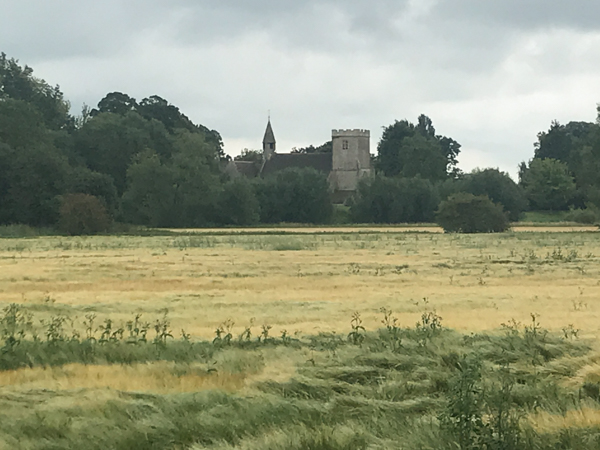
The first event of next year is our very own! Our webinars kick off on January 18 with an Introduction to the Thames Path. This is repeated every two weeks with the intervening week focusing on one of the four sections of the Thames Path. The series concludes on 8 March. Click here to register for these free events.
London Luminaries have published their winter virtual lecture series. These run from January 19 through to February 3 and feature Orleans House, Marble Hill, and Hogarth & Turner’s Houses, all found on the left bank near Twickenham. Tickets available here.
Staying with Marble Hill, you can learn how to make a bird box there on January 8. More details here.
If walking on the right bank through Rotherhithe next year you might want to take a detour to the Titanic Exhibition which is at Dock X in Surrey Quays. The exhibition opened this week. Tickets available here.
Reminders:
A new exhibition at the Stanley Spencer Gallery opened on November 4 entitled “Mind and Mortality, Stanley Spencer’s Final Portraits”. It focuses on some of his work as the artist approached the end of his life in 1959.
On 6 January 2022 an interactive digital reconstruction of Alexander Pope‘s villa and grotto will be held at The Exchange, Twickenham. A Virtual Arcadia has been created by Paul Richens of the University of Westminster and commissioned by Pope’s Grotto Preservation Trust. You can see a trailer on Youtube. Tickets available here.
Christmas has started at Kew Gardens where a series of illuminated trails will lead you to food and drink stalls. The gardens are open from 4pm to 10pm.
The Museum of London Docklands, part of the Museum of London, has a new exhibition entitled London: Port City, exploring how the port shaped the city, its people, places and language. The exhibition is free and runs until May 2022. The museum can be found close to Canary Wharf on the left bank of the Thames.
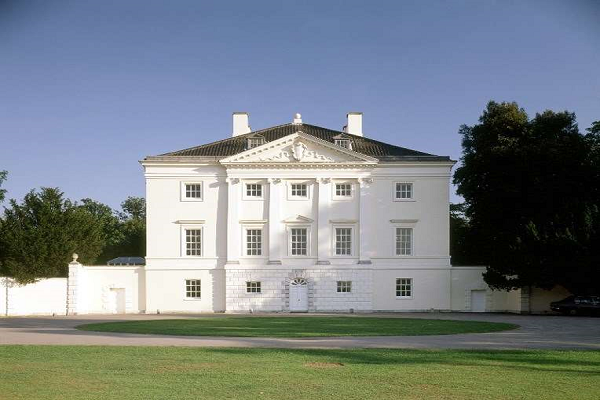
Website News
Two new products have been added to our online shop. These are both prints of the National Trail produced by Shepperton-based WordbirdCo. One is a customisable print (up to 50 characters); the other shows sections that can be ticked off. Both prints are available in two colours and three sizes.
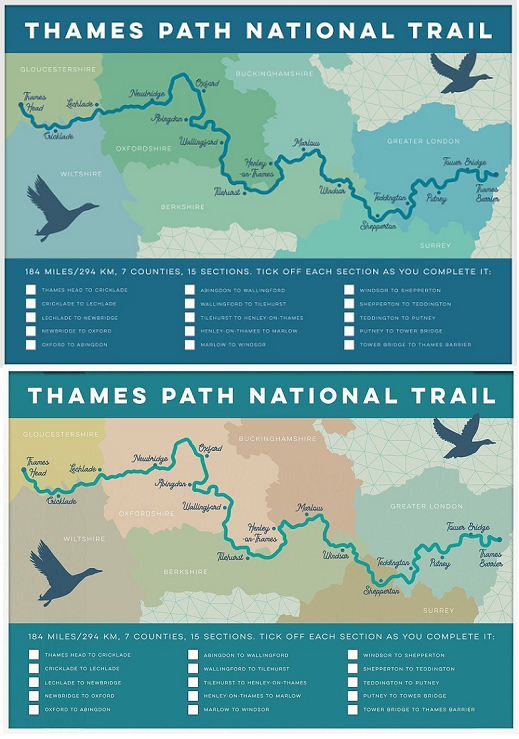
A Closer Look: The “Via Illuminati”
That’s not its official name but one we’ve coined and it refers, of course, to the Thames Path from Albert Bridge to Tower Bridge, its major bridges having been illuminated. The walk needs to be done at night to enjoy the bridges in their splendour. So it felt a little unusual setting off for a walk at 4pm in the afternoon close to the shortest day.
We chose the right bank. We’ve written before about how the right bank (also known as the south bank) is the preferred side. This is for two reasons: firstly, it’s more traffic free; secondly, it affords the best views of Westminster, St Paul’s and the Tower of London.
We set off through Battersea Park which, incidentally, closes around 10pm. There were plenty of people about but it was quite dark and very cold. Battersea Park sits between Albert and Chelsea bridges, both beautifully illuminated.
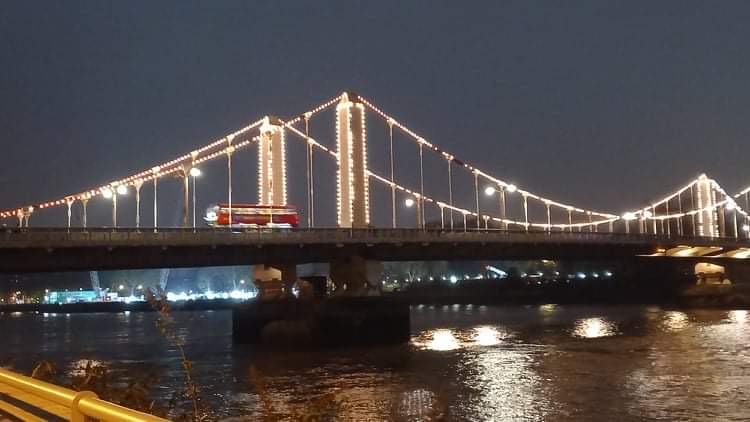
Immediately after Chelsea Bridge and past the unlit Grosvenor Railway Bridge stands Battersea Power Station – itself spectacularly illuminated. The river path comes to an abrupt end just past the pier and the Thames Path diverts past shops around the back of the station to briefly pick up Nine Elms Lane (A3205) until the riverside path can be rejoined opposite Waitrose. By the way, one of the disadvantages of walking in the dark is that it is difficult to see the diversion signs. And the river can’t be seen. But it can be sensed as it represents a gap between the lights.
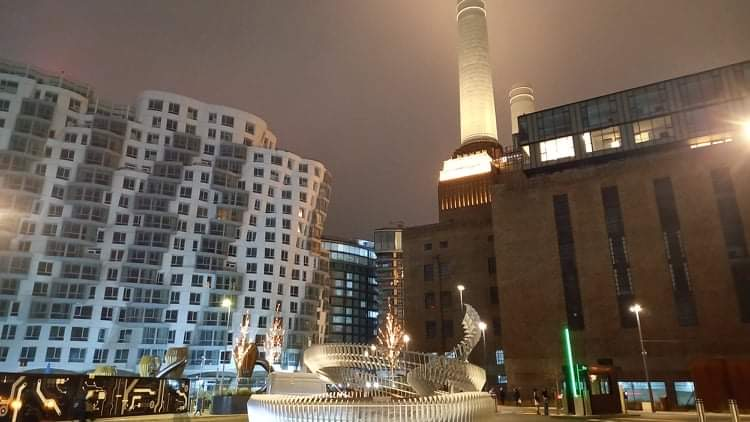
Nine Elms is a part of London that is being developed at a phenomenal rate. Some of London’s tallest buildings can be found here. It’s most famous is the US Embassy but we were keen to spot the swimming pool that had been built 115 feet high straddling two buildings. We were were not to be disappointed as it was illuminated. Certainly not as easy to spot in the light!
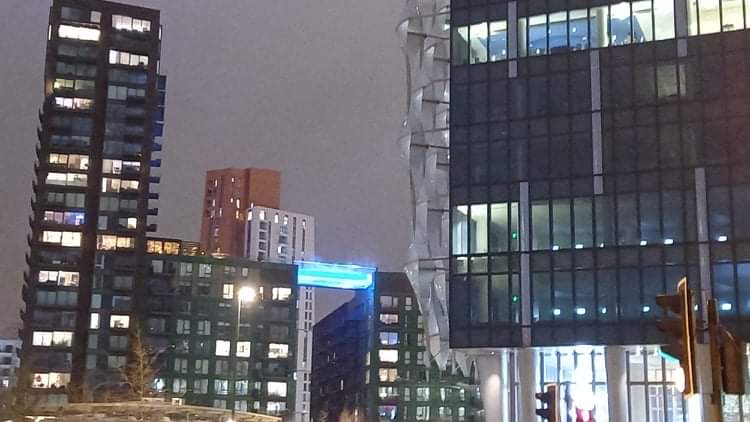
The MI6 Headquarters at Vauxhall Bridge were illuminated but, being on the same side as we were walking, the view was disappointing. In fact, at Vauxhall, you must walk around the back of the buidling (where, incidentally, you will be recorded by CCTV), and briefly follow the road until the riverside promenade opens up again. This was, perhaps, the most nostalgic view of all with Westminster Palace and Lambeth Bridge illuminated in a dark red appearing across the river with the beautiful street lights of Albert Embankment creating a Dickensian scene. The fact the weather was misty only added to the effect.
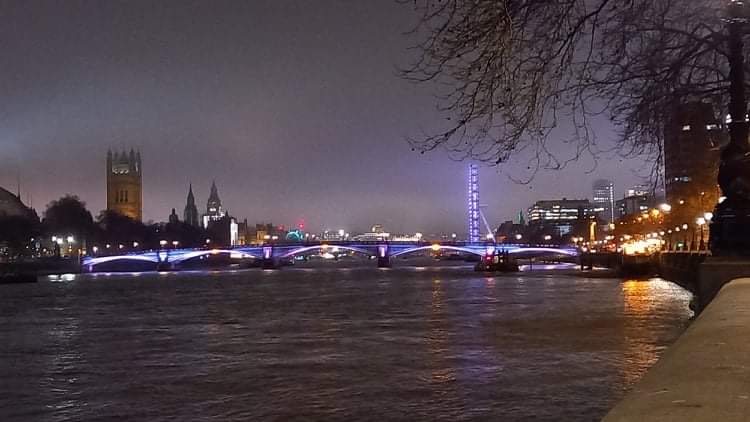
Between Lambeth and Westminster bridges lies the Covid Memorial Wall, the hearts starting to fade. But the views across to the Houses of Parliament are, again, quite special at night. Westminster Bridge is just over half-way and it was now 6pm. It soon became very busy as the area around the London Eye is full of stalls offering street food. The next bridge is Hungerford, a railway bridge but with a walkway on each side named the Golden Jubilee Bridges. The entire structure was illuminated.
Very soon you are at the South Bank where we stopped for dinner at the British Film Institute, which sits alongside Waterloo Bridge. This, like London Bridge, seems rather utilitarian by day; its simple illumination at night gives it a touch of class.
Next along is Blackfriars Bridge, which sits alongside the not quite so lovely Blackfriars Railway Bridge, although it is illuminated in its own way as the railway platform extends onto the bridge. It was at Blackfriars that we saw our only mudlarker, foraging on the shore with a torch as the tide almost at its lowest.
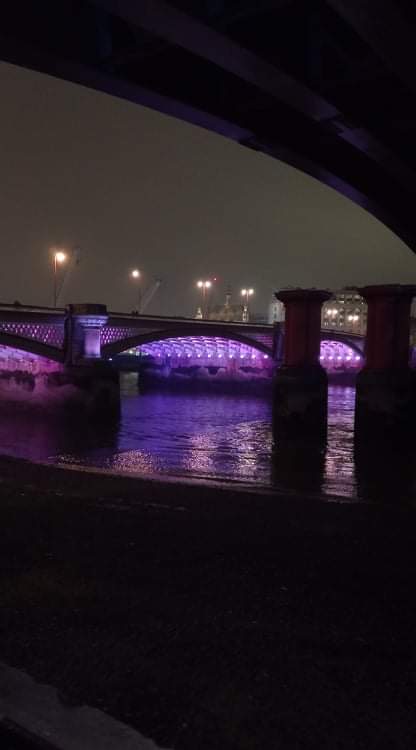
Just past Blackfriars is the Tate Modern, formed from Bankside Power station which, like Battersea, was designed by Sir Giles Gilbert Scott. Unlike Battersea, this was not illuminated and appeared rather sinister in the dark.
The Millennium Footbridge is next which sits directly opposite St Paul’s Cathedral, another glorious sight in the dark
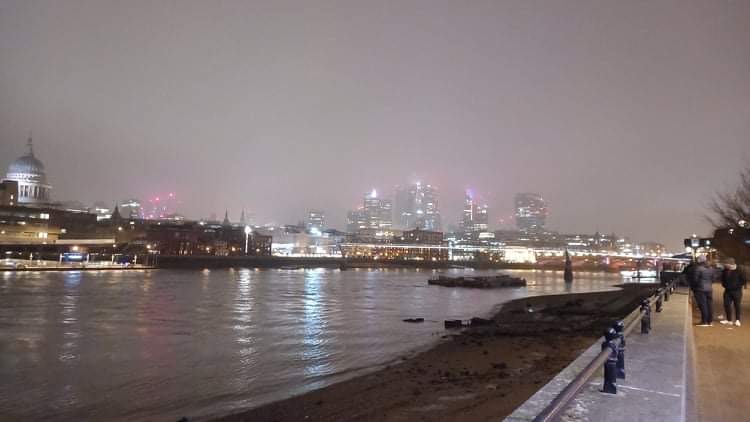
By now we could just about see the end of our walk, Tower Bridge. But first we had to pass an illuminated Southwark Bridge and then under the atmospheric arches of Cannon Street Railway Bridge and along Clink Street which takes you to the Golden Hinde. Frances Drake’s replica vessel was disappointingly dimly lit. However, we were more than compensated by the remains of Winchester Palace which were stunningly illuminated. Confession: having passed this way before a number of times, this was the first time to be drawn to this attraction – a good enough reason for taking a night walk. This was the mediaeval home of the Bishop of Winchester who was, by tradition, one of the most powerful men in the country serving as the king’s treasurer. Next door is Southwark Cathedral, dimly lit and therefore barely visible.
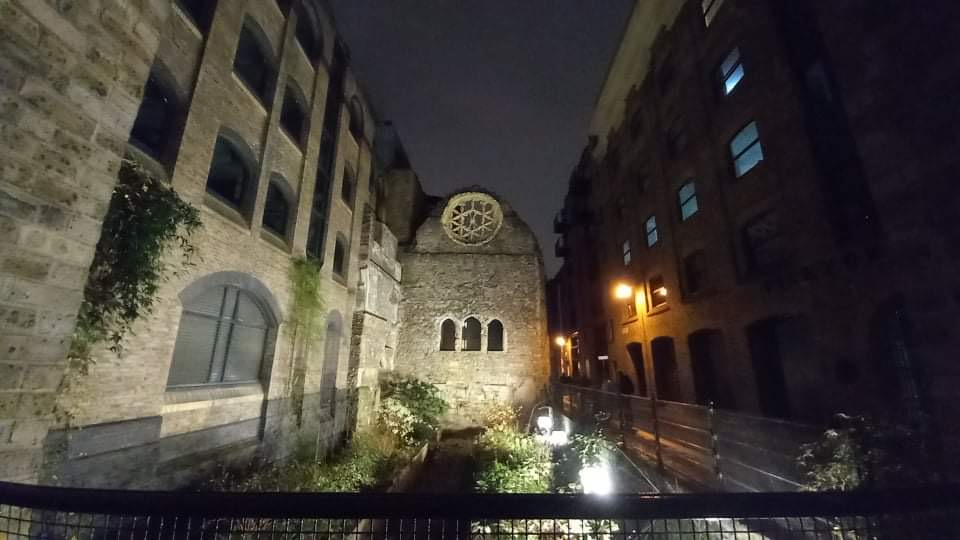
This stretch of the Thames Path takes you one block away from the river. It means you don’t see London Bridge until you’ve gone past it. In fact, an unprepossessing archway between Montague Close and Tooley Street provide a safe passage under the southern buttress of London Bridge. A dark passage on the left takes you back to the riverside where you can look back at the now elegant London Bridge, and forward to Tower Bridge (see cover photo), a half mile away. It’s a magical half mile too, with the skyscrapers of the city of London opposite and HMS Belfast guarding Tower Bridge. The final stretch by the City Hall was full of festive stalls; in stark contract to the brooding appearance across the river of Traitors Gate and the Tower of London.
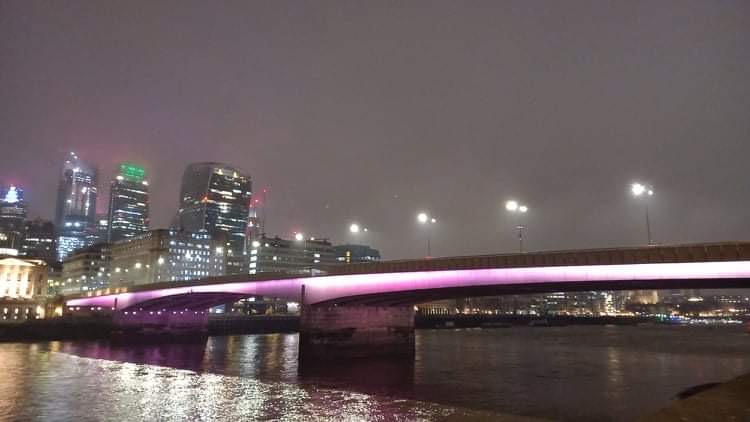
Tower Bridge provides an interesting perspective. Upstream, lights are blazing and there are bridges galore. Downstream, and the last few miles of the Thames Path, looked eerily quiet, a reminder that London falls away sharply past Tower Bridge. London’s wealth was built on its ports which stopped just before Tower Bridge. Its wealth financed the grand buildings we see for so many miles upstream. But as the ships became bigger and the ports moved downstream, a vacuum was created which is slowly being filled.
And finally….
This will be the last newsletter of the year. Our next newsletter will be issued around January 2. We will be answering emails throughout the festive period and able to process bookings and shop sales.
We would like to wish you and your families a blessed Christmas and a Happy New Year.
Ready to book?
| Cookie | Duration | Description |
|---|---|---|
| cookielawinfo-checkbox-analytics | 11 months | This cookie is set by GDPR Cookie Consent plugin. The cookie is used to store the user consent for the cookies in the category "Analytics". |
| cookielawinfo-checkbox-functional | 11 months | The cookie is set by GDPR cookie consent to record the user consent for the cookies in the category "Functional". |
| cookielawinfo-checkbox-necessary | 11 months | This cookie is set by GDPR Cookie Consent plugin. The cookies is used to store the user consent for the cookies in the category "Necessary". |
| cookielawinfo-checkbox-others | 11 months | This cookie is set by GDPR Cookie Consent plugin. The cookie is used to store the user consent for the cookies in the category "Other. |
| cookielawinfo-checkbox-performance | 11 months | This cookie is set by GDPR Cookie Consent plugin. The cookie is used to store the user consent for the cookies in the category "Performance". |
| viewed_cookie_policy | 11 months | The cookie is set by the GDPR Cookie Consent plugin and is used to store whether or not user has consented to the use of cookies. It does not store any personal data. |